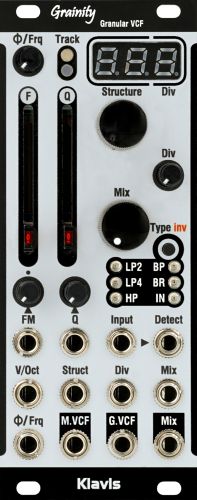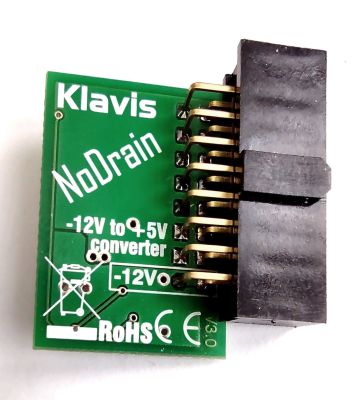Presenting our craftsmanship
Forthcoming products
Terminal 4
Quad VCA, LPG, Envelope generatorVersatility and power in 8hp for the functions you need and love, especially for portable live setups.
Each pair of the 4 channels can be set in stereo or used independently.
Each of the 4 EG can act on its VCA/LPG or generate an envelope CV.
The module is DC-coupled to accept CV and audio.
Unconnected outputs are automatically down mixed
- Settings:
Control signal level + CV
lin-log curve
Offset level
Balance + CV
LPG preset selection
Zero-crossing enable
Envelope 8-template selection
Envelope global time


Current products
Grainity
The first Granular VCF in the world
The Grainity brings the unique and never-heard-before concept of granular sound synthesis to VCFs.
With a 100% analog filtering path under digital control, the Grainity expands and enriches the sound in creating subharmonics, tunable harmonies, unison, flanging effects and formant filtering all at once.
The module presents two parallel sections, the granular filter itself and a typical multimode filter, each with its own output, plus a 3rd mix output of both sections.
Numerous controls and CV allow a very wide palette of results.


Twin Waves MK II
Dual VCO/LFO/RandomTwo independent oscillators with 20 algorithm-based sound synthesis options offer a wide palette of tonal variations or can be switched into highly versatile LFOs.
-
Thick unison, waveshaping, additive, self-sync, noise with resonant VCF, ring modulation, bit-crushing, sub-osc out and more; all enriching your musical horizons.
The tuning can be locked, changing the Coarse knob into an octave selector.
Each VCO has its own quantizer with 21 different musical scales.
As LFO, you have wave shaping, plus clocking with manual/CV controlled div/mult and sync capabilities.
A semi-modular normalizing opens the realm of cross modulation without additional cables; just twist the pots!
With its icons and on-demand scrolling information, the display avoids the need of a cheat sheet. No feature is more than one-level button press accessible.


Quadigy
Quad programmable envelope generator
The Quadigy is a poweful envelope generator focused on live play.
The goal is to allow you setting up rich, interactive and dynamically evolving envelopes without the risk of breaking up a subtle and intricate patch once on stage.
Seven-stage envelopes with independent A, D, R curve settings can be saved in 32 presets and recalled by CV or clock to be tweaked further on.
Cycle settings allow LFO-like shapes that can be clock controlled, imposing the tempo to the envelopes with automatic stretching/compressing of the timings to make them fit.
A powerful CV matrix allows modulating every parameter in every envelope with independent amplitude and polarity.
CalTrans
Quad Volt/Octave calibrator & TransposerThe CalTrans solves issues encountered when playing tonal music with a modular system: tracking problems, curves unrelated to V/Oct ratio, limited octave range, cumbersome transposition, ...
The Caltrans corrects and expands the range of troublesome VCOs and brings V/Oct tracking to anything that oscillates including Hz/Volt Korg synths.
Besides calibration, the CalTrans offers live play features.
Each channel can be quantized and any combination of them transposed jointly.
A pair of rotary encoders allow a quick selection of octaves and semitones.
You can add a pinch of portamento and glissando to each channel and save the whole in user presets.


Tweakers
Dual CV Gain, Offset, Polarity and MuteThe Tweakers is a slim companion module that allows fine tuning your modulations.
-
Two channels each offer control over gain and offset.
Three-position switches allows muting the channels and inverting their modulation polarity without impacting the offset.
Normalizing of the inputs avoids using a multiple when a signal is dispatched to two targets. Normalizing of the outputs offers an bonus mixer, summing the two channels.
The Tweakers is the perfect addition for modules whose modulation inputs lack such amenities.
Activating predefined settings at the flick of a switch is paramount for live situations. Being able to prepare two sets of carefully adjusted settings for a given signal is even more useful. The Tweakers may come handy as an audio mixer too.


Tweakers Plus
Dual CV Gain, Offset, Polarity and Mute + Output LEDsThis is a 1U-high companion module that allows fine tuning your modulations.
-
Two channels each offer control over gain and offset.
A three-position switch allows muting the channel and inverting the modulation polarity without impacting the offset.
Normalizing of the inputs avoids using a multiple when a signal is dispatched to two targets. Normalizing of the outputs offers an bonus mixer, summing the two channels.
The Tweakers is a perfect addition for modules whose modulation inputs lack such amenities. This 1U version offers output LEDs to monitor the amplitude and polarity.
Activating predefined settings at the flick of a switch is paramount for live situations. Being able to prepare two sets of carefully adjusted settings for a given signal is even more useful. The Tweakers may come handy as an audio mixer too.

Mixwitch
Mixer & Clock/CV controlled SwitcherWith only a pinch of mixing, inverting and controlled switching, we brew up a plethora of combinations and uses. The user manual presents eighteen use cases.
Two mixers can be used separately or with the 4 channels mixed into one.
Polarity control and muting are under digital control for noise free operation.
When not used for CV, the Log button halves the mixer gain and changes the curve of the pots into logarithmic for precise audio control without clipping.
LEDs indicate each input's polarity, the Log mode and each output's signal amplitude and polarity.
A switching section allows selecting the inputs via CV or clock with cyclic or random order for sequencing fun.


ComPair
Window/Dual Voltage comparatorsThis module can be used as a pair of independent voltage comparators or a single window comparator.
Three outputs relay the comparison of the voltage(s) against the threshold levels set with the potentiometers. The Hi pot setting can be offset with a CV; this allows comparing two voltages against each other.
Each logic output is fit with a 3-position switch to signal a comparison match, lack of it, or to be muted. LEDs indicate which output is currently active.
The combination of modes and settings leads to numerous applications encompassing logic and analog level detection.
The module works from DC to beyond-audio range.
Its outputs can be logic-Ored by shorting them with a multiple


Flexshaper
CV-controlled voltage mapper and waveshaperThis module can act as an envelope-shaping tool, frequency multiplier, waveshaper, clipper, distortion, limiter, curve changer, and more. Five settings + CV inputs offer limitless control over the placement of the voltage points for dynamic signal sculpting.
The idea of the Flexshaper comes from a feature in the Oberheim® Matrix synthesizers called Tracking Generator.
The Flexshaper applies the same concept using the same 5 shaping points. However, it goes beyond Oberheim’s implementation on two main aspects:
-
It goes fast enough to process signals at full audio rate
The 5 points are dynamically adjustable (CV) in real-time
Besides, the Flexshaper can process adequately bipolar and unipolar Eurorack signals, even changing one type into the other.
DC-coupling handles both audio and modulation signals.


Two Bits
Dual logic processor with chaining and CV functionsTwo dual-input sections can be used independently, put in parallel for 4-input wide logic, or chained for more advanced processing.
Each section presents normal and inverted outputs.
The two sections offer a set of common and specific functions for a total 15 different ones; 30 when counting the inverted resuts (e.g. OR/NOR).
Several functions offer real-time CV control for dynamic change of their condition or setting.
All time-related functions can be independently user-adjusted and are saved automatically.
LEDs tell permanently the status of all outputs.


Logica XT
Voltage-controlled logic and gate processorBesides the whole set of mainstream boolean logic, the Logica XT offers several unique functions based on state-logic, for a total of 12 functions, 24 with the inverted ones (e.g. And/Nand).
Three inputs + manual control brings you where other logic modules can't go.
Simultaneous normal and inverted outputs are completed with a div/2 output that expands its usability.
Time-related functions are user-adjutable and stored automatically; pulse lengths and delay duration can be adjusted from milliseconds to several seconds with perfect repeatable precision.
Selecting the functions with a CV brings the entirely new concept of timing-controlled randomness into logic decisions.


2x4 Multiple
Dual section passive multipleElegantly matches the side stripes of Klavis modules, as well as all-black setups.
A multiple is a required utility sitting efficiently next to modules whose signals should be dispatched to more than a single destination.
This a passive module that doesn't require a supply connection.
Surprisingly, a multiple could also be used with Klavis logic modules (Logica XT, Two Bits, ComPair) for additional OR logic.
Indeed, these logic modules allow their outputs to be ORed by simply connecting them together.
With 4 jacks in one section of the multiple, 3 inputs to 1 output and 2 inputs to two destinations are both feasible.
Beware that such direct ORing feature might not be available with other brands of modules!


NoDrain
Negative to +5V converterReclaim your unused watts !
Did you know that typical 5V adapters draw 240% of the actual wattage they deliver, with 140% being wasted as heat ? Moreover they take it from your precious +12V rail.
Beating even other switching-supply adapters, the NoDrain converter takes its power where there is plenty unused: the -12V negative rail !
The NoDrain adapter does its conversion with high efficiency.
One full Amp of 5V takes less than 0.5 Amp on the -12V.
With 1 amp available, you can distribute the 5V from the NoDrain to several busboards.
Thanks to ultra-high-speed switching technique there is no noise to be heard.

Black modules & panels
After much delay, we have expanded our range with black panel versions.
These are made of 2mm-thick brushed aluminium, bath-anodised on all sides, and screen-printed with a high-resistance white-silvery paint.
Modules with black panels
The whole range is available with black panels.
(to the exception of the 2x4 Multiple)
Separate black panels
For black look afficionados who bought Klavis modules before our black versions were available, we offer replacement panels.
Only the following user-replaceable black panels are available:
-
CalTrans
Flexshaper
Logica XT
Mixwitch
Tweakers
Two Bits
Black panels are not offered for Quadigy and Twin Waves (V1 & MKII) for technical reasons that may lead to after-sales issues.

Discontinued products
Twin Waves (V1)
Voltage-controlled Dual VCO/LFOThe driving idea behind the Twin waves voltage-controlled dual oscillator/LFO is to offer two interesting oscillators in a skiff-friendly and compact size.
To achieve that challenge, we built the product’s architecture on the concept of pre-defined algorithms, where the most useful configurations and their matching parameter are ready to use.

Logica Gater
Voltage-controlled logic and gate processorLogic functions are a longtime ally in the modular toolbox.
In the typical Klavis’ approach, we had to bring something extra to the party.
First, we made the selection of the logic function controllable by a voltage; this way creative dynamics can be put in place.
Secondly, we have our unique Gater function which combines gates in a way no traditional logic function does: it creates as many individual gate triggers on the output jack as are arriving on the various inputs.

Inspiration technology to let you create the difference
©2018-2024 Diagonal Electronics



